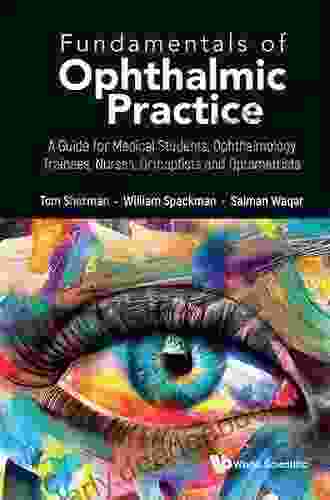Fundamentals In Ophthalmic Practice Anita Kelly: A Comprehensive Guide

Ophthalmic practice is a specialized field of medicine that deals with the diagnosis and treatment of eye diseases. Ophthalmologists are medical doctors who have completed additional training in the diagnosis and treatment of eye conditions. They are qualified to perform a variety of procedures, including eye exams, laser surgery, and cataract surgery.
4.3 out of 5
| Language | : | English |
| File size | : | 43520 KB |
| Text-to-Speech | : | Enabled |
| Screen Reader | : | Supported |
| Enhanced typesetting | : | Enabled |
| Print length | : | 380 pages |
| X-Ray for textbooks | : | Enabled |
This article will provide a comprehensive overview of the fundamentals of ophthalmic practice, covering topics such as anatomy, physiology, and common eye diseases. It will also include helpful tips for eye care professionals and patients alike.
Anatomy of the Eye
The eye is a complex organ that is responsible for vision. It is made up of several different parts, including the cornea, pupil, iris, lens, retina, and macula.
The cornea is the clear, dome-shaped structure that covers the front of the eye. It helps to focus light on the retina.
The pupil is the black opening in the center of the iris. It allows light to enter the eye.
The iris is the colored part of the eye. It controls the size of the pupil.
The lens is a clear, flexible structure that is located behind the iris. It helps to focus light on the retina.
The retina is the light-sensitive tissue that lines the back of the eye. It contains millions of cells that convert light into electrical signals.
The macula is a small area of the retina that is responsible for central vision. It is responsible for our ability to see fine details.
Physiology of the Eye
The eye works by focusing light on the retina. The cornea and lens work together to bend light rays so that they converge on the retina. The retina then converts the light into electrical signals that are sent to the brain.
The brain interprets the electrical signals from the retina and creates an image of the world around us.
Common Eye Diseases
There are a number of different eye diseases that can affect people of all ages. Some of the most common eye diseases include:
* Cataracts: Cataracts are a clouding of the lens that can lead to blurred vision, glare, and difficulty seeing in low light. * Glaucoma: Glaucoma is a condition that damages the optic nerve, which can lead to vision loss. * Macular degeneration: Macular degeneration is a condition that affects the macula, which can lead to blurred vision and difficulty seeing fine details. * Diabetic retinopathy: Diabetic retinopathy is a condition that affects the blood vessels in the retina, which can lead to vision loss.
Tips for Eye Care Professionals
* Be patient and understanding with your patients. They may be anxious or nervous about their eye exam or treatment. * Explain everything to your patients in a clear and concise way. They need to understand their condition and their treatment options. * Be available to answer your patients' questions and concerns. They need to feel like they can trust you. * Stay up-to-date on the latest advancements in eye care. This will help you provide the best possible care to your patients.
Tips for Patients
* Get regular eye exams. This is the best way to detect and treat eye diseases early on. * Wear sunglasses to protect your eyes from the sun's harmful UV rays. * Eat a healthy diet that includes plenty of fruits, vegetables, and whole grains. This will help to keep your eyes healthy. * Get enough sleep. This will help to reduce your risk of developing eye problems. * Avoid smoking and drinking alcohol. These substances can damage your eyes. * If you have any concerns about your vision, don't hesitate to see an ophthalmologist. Early detection and treatment can help to prevent serious vision loss.
Ophthalmic practice is a challenging but rewarding field of medicine. Ophthalmologists are able to make a real difference in the lives of their patients by helping them to see the world around them more clearly.
This article has provided a comprehensive overview of the fundamentals of ophthalmic practice. By understanding the anatomy, physiology, and common eye diseases, you can be better prepared to take care of your own eyes and the eyes of your loved ones.
4.3 out of 5
| Language | : | English |
| File size | : | 43520 KB |
| Text-to-Speech | : | Enabled |
| Screen Reader | : | Supported |
| Enhanced typesetting | : | Enabled |
| Print length | : | 380 pages |
| X-Ray for textbooks | : | Enabled |
Do you want to contribute by writing guest posts on this blog?
Please contact us and send us a resume of previous articles that you have written.
 Book
Book Chapter
Chapter Story
Story Reader
Reader E-book
E-book Newspaper
Newspaper Paragraph
Paragraph Bookmark
Bookmark Shelf
Shelf Glossary
Glossary Foreword
Foreword Preface
Preface Synopsis
Synopsis Annotation
Annotation Footnote
Footnote Scroll
Scroll Tome
Tome Bestseller
Bestseller Classics
Classics Memoir
Memoir Reference
Reference Thesaurus
Thesaurus Narrator
Narrator Resolution
Resolution Librarian
Librarian Catalog
Catalog Card Catalog
Card Catalog Stacks
Stacks Periodicals
Periodicals Study
Study Research
Research Lending
Lending Reserve
Reserve Rare Books
Rare Books Special Collections
Special Collections Interlibrary
Interlibrary Literacy
Literacy Study Group
Study Group Storytelling
Storytelling Textbooks
Textbooks Alex Brown
Alex Brown Doreen L Marquart
Doreen L Marquart Gavin Thomson
Gavin Thomson Wally Wood
Wally Wood Maria K
Maria K Todd Debreceni
Todd Debreceni Ricky Martin
Ricky Martin Maureen Buchanan Jones
Maureen Buchanan Jones Tricia Frey
Tricia Frey Naoko Aita
Naoko Aita Randall Wright
Randall Wright Gabriel Krieshok
Gabriel Krieshok Elena M Reyes
Elena M Reyes Carmel Harrington
Carmel Harrington John Deferrari
John Deferrari Shannon Hale
Shannon Hale Remo F Roth
Remo F Roth Thomas Angelo
Thomas Angelo Stella Wilkinson
Stella Wilkinson C T Phipps
C T Phipps
Light bulbAdvertise smarter! Our strategic ad space ensures maximum exposure. Reserve your spot today!

 Dwayne MitchellYour Ticket to Staging a Successful Play from Start to Final Curtain: A...
Dwayne MitchellYour Ticket to Staging a Successful Play from Start to Final Curtain: A...
 Jorge Luis BorgesSustainability Assessment Applications and Opportunities: A Comprehensive...
Jorge Luis BorgesSustainability Assessment Applications and Opportunities: A Comprehensive...
 Spencer PowellHigh Yield Review for the Otolaryngology In-Service and Board Exams: The...
Spencer PowellHigh Yield Review for the Otolaryngology In-Service and Board Exams: The...
 Efrain PowellElder Bonds: Immortal Curse World - An Immersive Symphony of Dark Fantasy and...
Efrain PowellElder Bonds: Immortal Curse World - An Immersive Symphony of Dark Fantasy and... Osamu DazaiFollow ·12.9k
Osamu DazaiFollow ·12.9k Efrain PowellFollow ·5.3k
Efrain PowellFollow ·5.3k Aron CoxFollow ·14.9k
Aron CoxFollow ·14.9k Spencer PowellFollow ·12.5k
Spencer PowellFollow ·12.5k Jordan BlairFollow ·16.1k
Jordan BlairFollow ·16.1k Neil ParkerFollow ·7k
Neil ParkerFollow ·7k Felix HayesFollow ·16.3k
Felix HayesFollow ·16.3k Edmund HayesFollow ·14.6k
Edmund HayesFollow ·14.6k

 Houston Powell
Houston PowellMusorgsky and His Circle: A Russian Musical Revolution
Modest Mussorgsky was a Russian...
 Barry Bryant
Barry BryantRanking the 80s with Bill Carroll: A Nostalgic Journey...
Prepare to embark on a captivating...

 Kelly Blair
Kelly BlairThe Diplomat's Travel Guide to Festivals, Holidays, and...
India is a land of vibrant culture and...

 José Saramago
José SaramagoFancy Nancy Nancy Clancy: Late-Breaking News!
Nancy Clancy is back with all-new adventures...

 Trevor Bell
Trevor BellGestalt Psychotherapy and Coaching for Relationships: A...
Relationships...

 Federico García Lorca
Federico García LorcaThe Last Love of George Sand: An Enduring Legacy of...
At the twilight of her remarkable life,...
4.3 out of 5
| Language | : | English |
| File size | : | 43520 KB |
| Text-to-Speech | : | Enabled |
| Screen Reader | : | Supported |
| Enhanced typesetting | : | Enabled |
| Print length | : | 380 pages |
| X-Ray for textbooks | : | Enabled |




